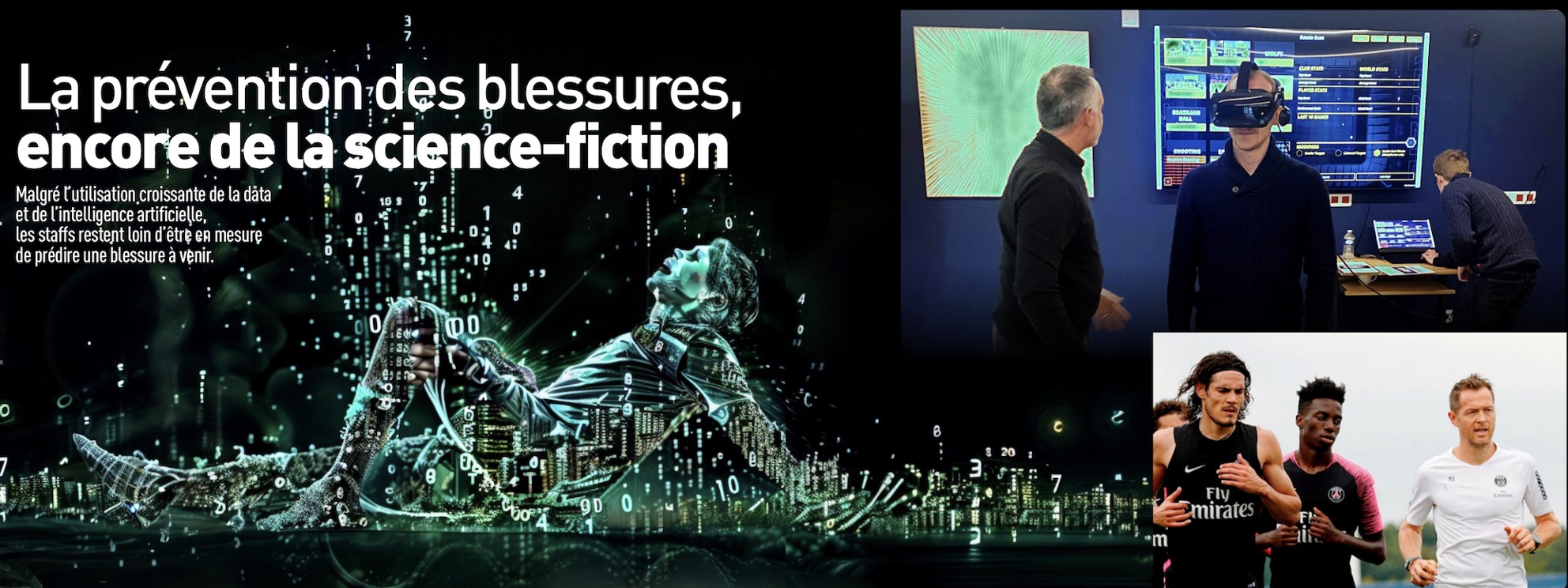Metabolic power: powerful enough to drive Ferraris?
After many requests following my talk in Aspire last year (Monitoring Load conference, Doha, Qatar, 2016) where I takled the metabolic power concept, I have just put together a written version of this specific section (that will also partly be inlcuded in a IJSPP paper written with Ben Simpson now available here)
Since Osgnagh et al. in 2010,13 who showed the potential application of the metabolic power (MP) concept8 for load monitoring in soccer, the interest for this variable has grown exponentially and is now used across many other team sports.6, 7, 12, 16 In fact, most GPS brands offer now the ability to monitor players’ MP, and a majority of practitioners use this variable when reporting.1 While we have been the firsts to be excited about the potential of this monitoring approach, we have since reconsidered our opinion and question now its usefulness in the field to monitor elite players (i.e., “Ferraris”). This is essentially related to i) recent research findings questioning its validity in the context of team sports-specific movements and ii) the fact that it is only an incomplete metabolic measure of internal load and probably too broad a marker of external load.
What do we actually measure?
It has now been shown by four distinct and independent research groups that locomotor-related MP assessed via either GPS or local positioning system (PGPS or Pmet in the figure below) differs largely from the true metabolic demands as assessed via indirect calorimetry (VO2 measures, PVO2). PGPS was actually reported to be very largely greater than PVO2 during walking,3 but very largely lower during shuttle runs at low speed15 and during soccer-,4 rugby-11 or team-sports3 specific circuits.
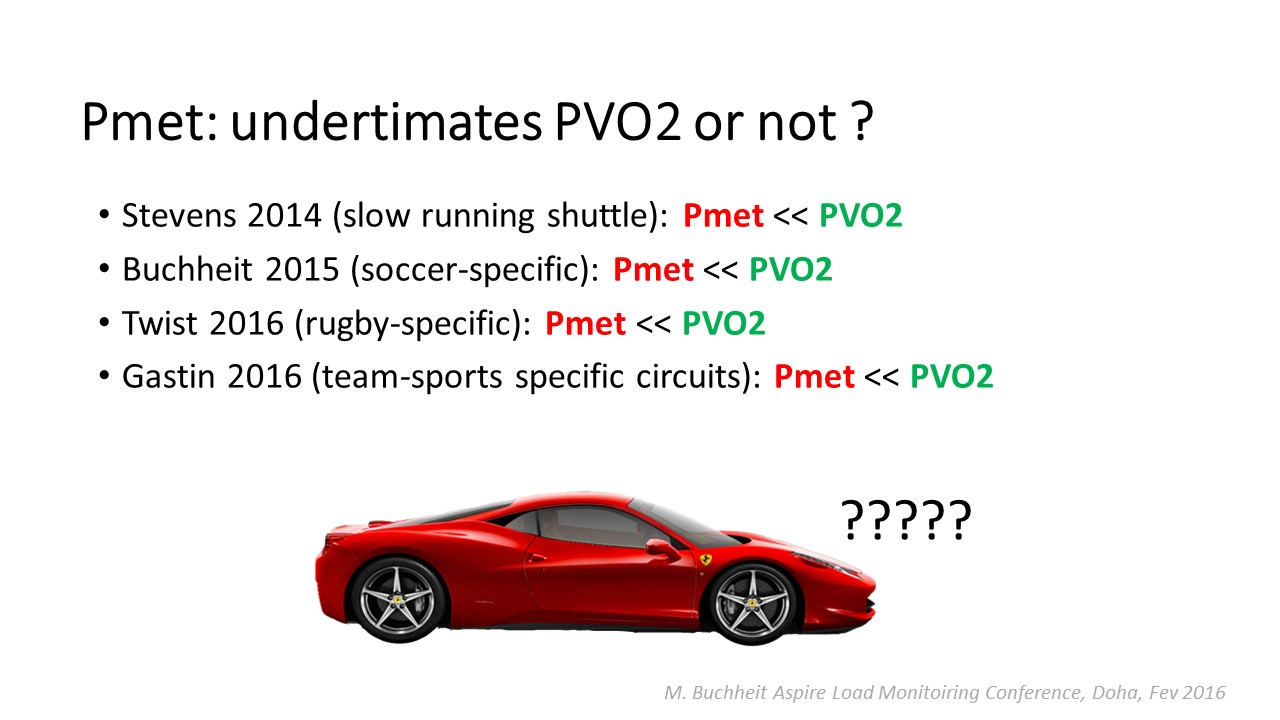
While some may see the consistency of such conclusions as a kind of consensus, Osgnach et al. wished to write a letter to the editor to defend their approach and criticize our methodology.14 Since we were not given the chance to respond to this letter by the IJSM editor (“you will not be invited to respond to this letter, but I am sure that you will discuss directly this interesting issue with the di Prampero group”), we wished to comment on their main critics in the present post. This should clarify some discussions and confirm the limitations of MP in the context of interest, i.e., monitoring team-sports specific efforts with the available technology on the market.
- Resting VO2
- Osgnagh et al.: “Buchheit et al. have included resting VO2 in their calculations; using net VO2 as in the original methodology would reduce the difference observed and PGPS won’t appear to be underestimated anymore.”14
- Response: we have in fact used net VO2, as clearly written p1151, 2nd paragraph “Average net VO2 and the respiratory exchange ratio (RER) were calculated for each of the three 1-min efforts and the following 30-s recovery periods”4
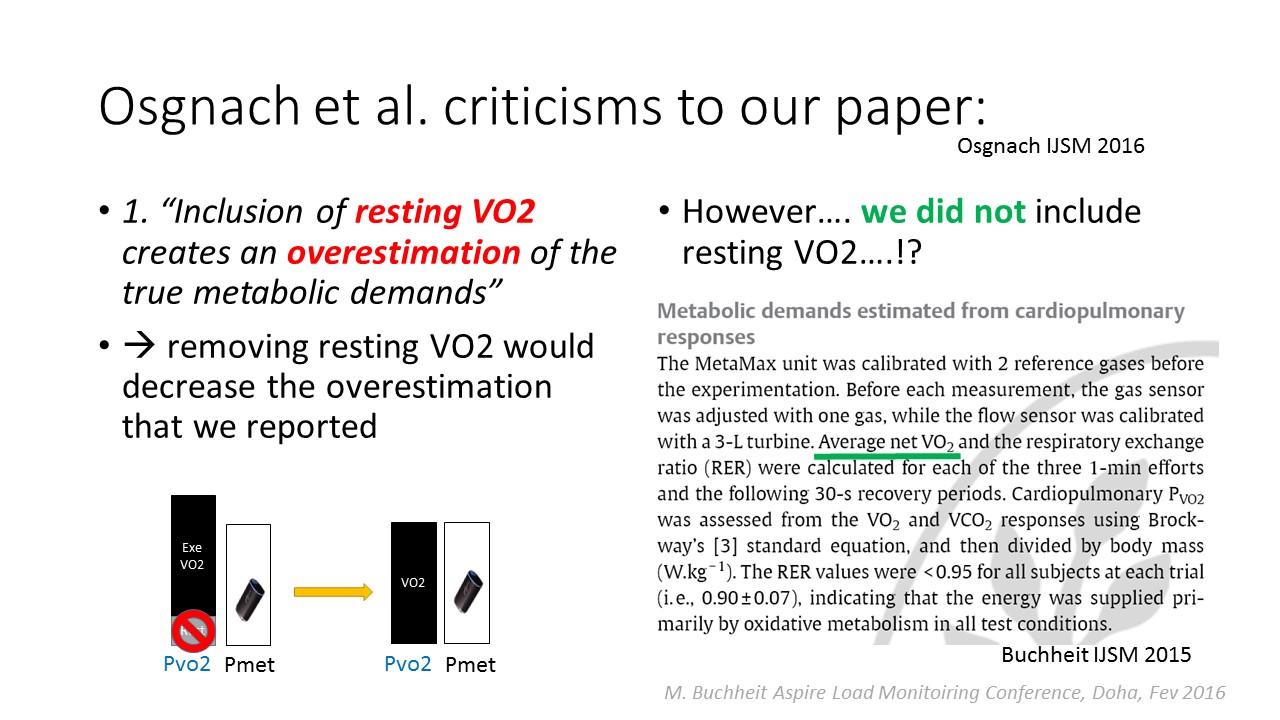
- Anaerobic energy contribution
- Osgnagh et al.: “Anaerobic energy contribution is not appropriately accounted for in the calculation (the intensity of some efforts may be greater than VO2max, so that they are missed in the overall metabolic cost).”14
- Response: Agree. But in this case, the actual (true) metabolic demands would have been even greater than those measured, which suggests that the PGPS underestimation would have actually been even greater than that reported in our paper!4
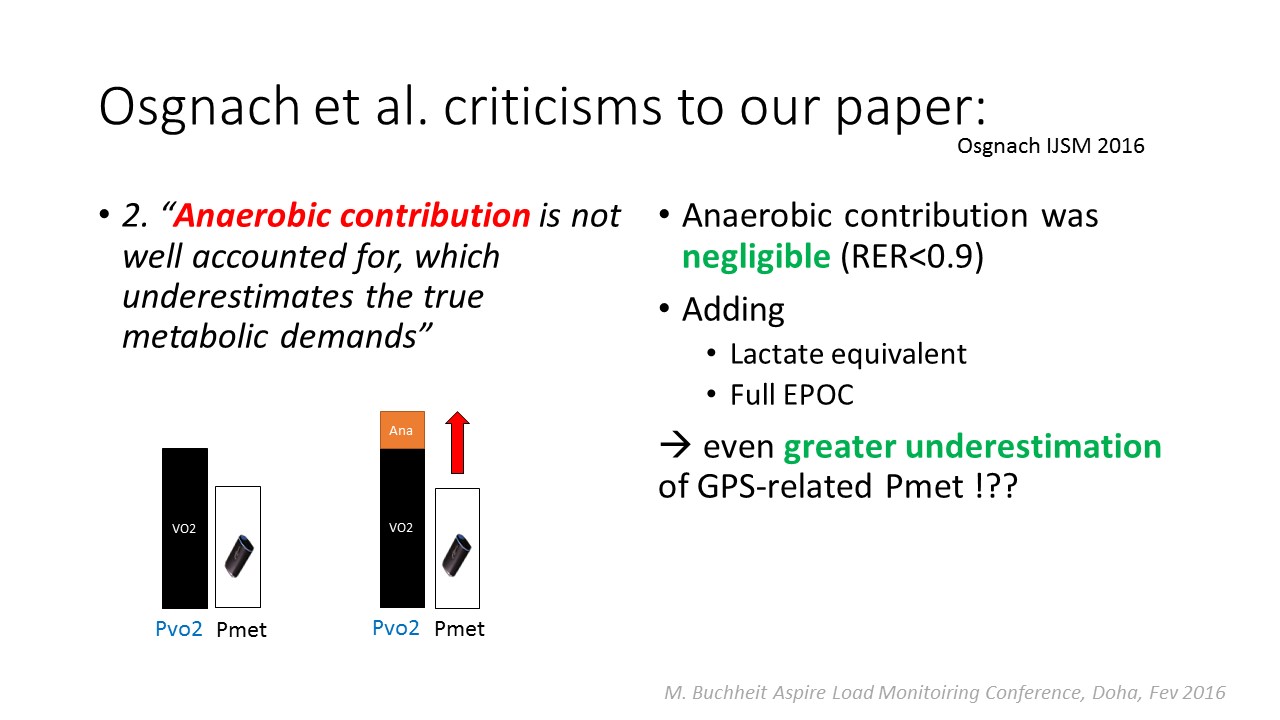
- Impact of non-locomotor actions
- Osgnagh et al.: “as shown in Buchheit’s Figure 2, VO2 increases markedly at several points, while the simultaneously determined MP remains close to zero.”14 They suggest that something was wrong with our data.
- Response: Soccer as most other team sports often includes intense but static movements (passing a ball for example, as in our circuit). It is therefore obvious to observe a rise in VO2 that is not associated with locomotor movements and in turn, changes in MP. This is an important limitation of MP – which may only reflect locomotor-related metabolic activity. But if that was the case, what would be the value of such an impartial measure of metabolic load? This is at odds with all attempts to use MP outputs for overall load monitoring or nutritional (post training/matches recovery) guidelines.6
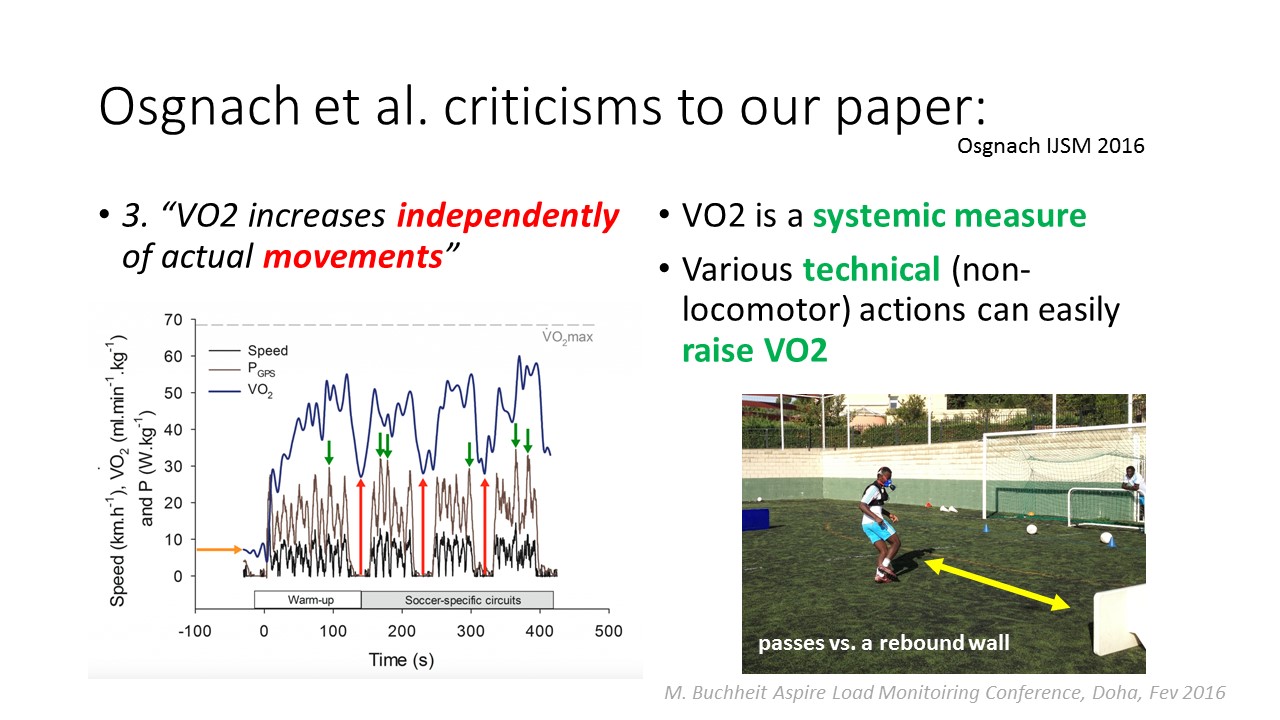
- Sampling frequency
- Osgnagh et al.: “The low sampling frequency of the GPS device used is problematic and explains the underestimation of PGPS.”14
- Response: while we agree that 4 Hz as used in our study can be considered as low, we don’t believe that this may be the cause of the underestimation since the other researchers have all reported the same underestimation using higher sampling frequencies (i.e., 500,15 1011 and 53 Hz). Note also that we have shown that sampling frequency per se was not the most important factors when it comes to precision and validity.5
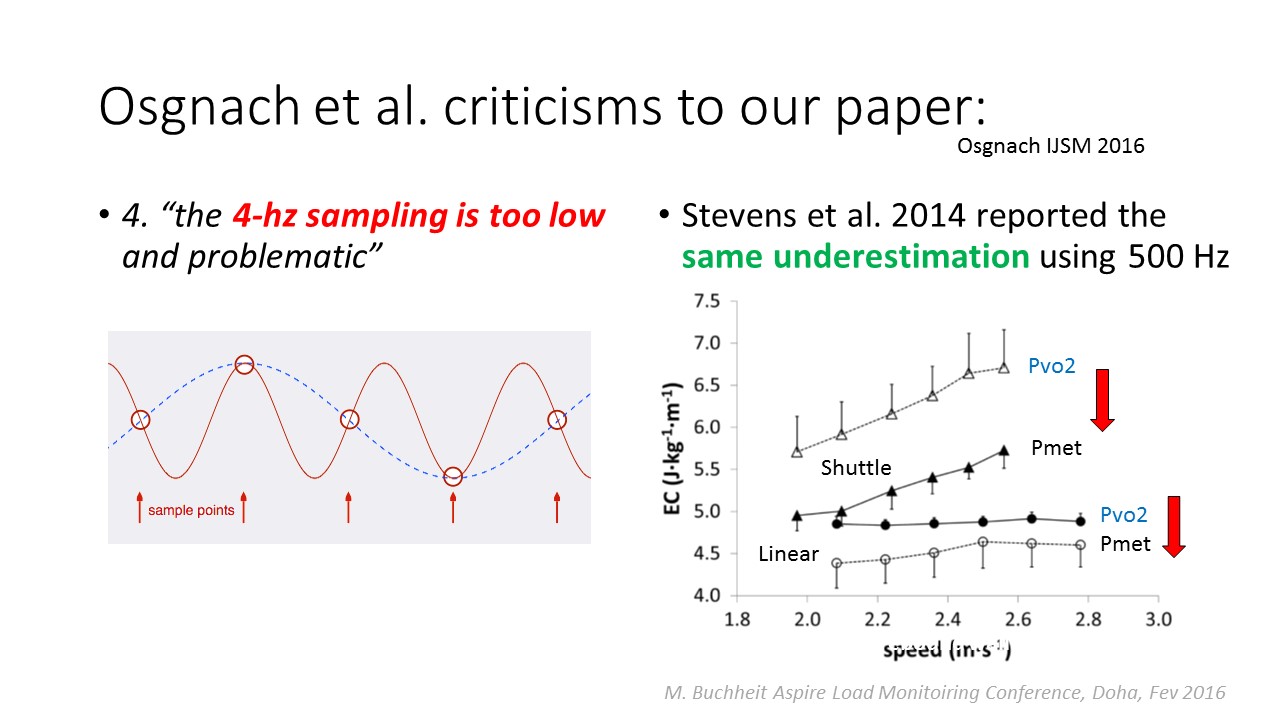
Added value to load monitoring systems?
Considering that the agreement between PGPS and PVO2 has only been shown to be acceptable during continuous and linear jog and runs (but neither during walking nor intermittent changes of direction runs)3, the metabolic underestimation may be related to the fact that the current equation initially developed for maximal and linear sprint acceleration8 may not be well suited for team-sport specific running patterns (e.g., including rest, irregular step frequency and stride length, turns, upper body muscle activity, static movements).4
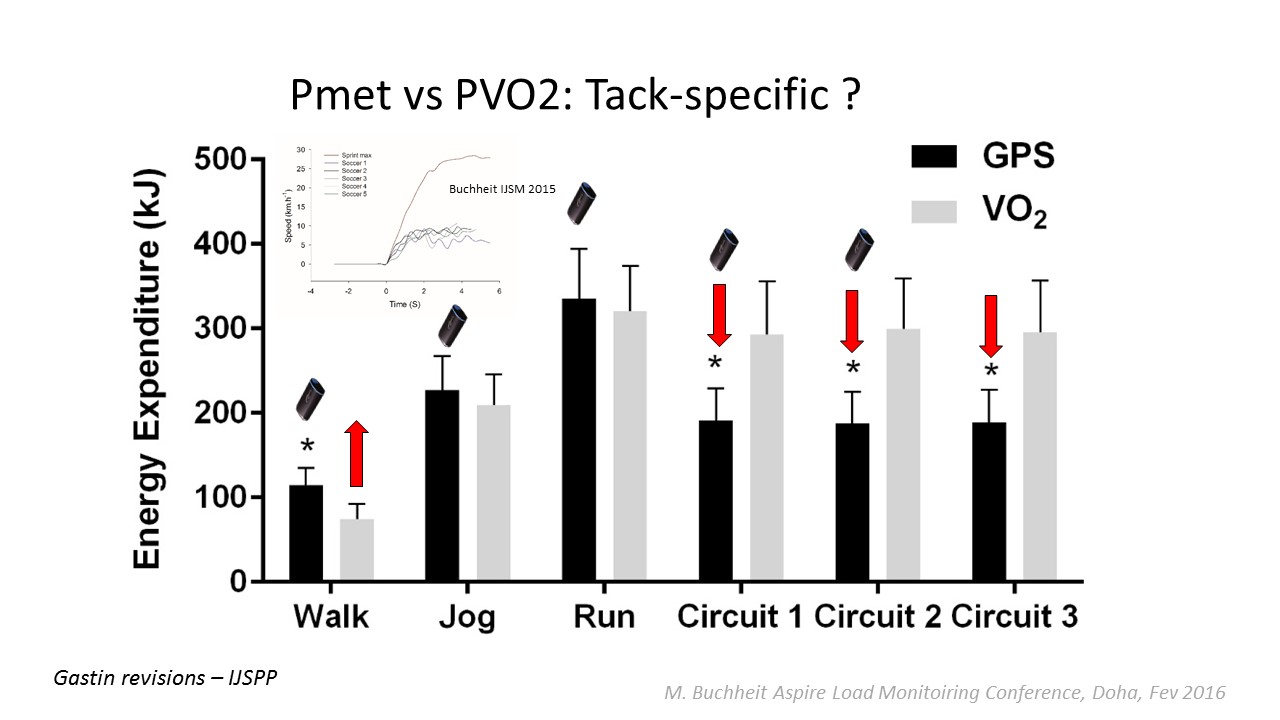
This suggests that the value of PGPS per se to monitor training load in team sports may be questionable. Its usefulness may also be limited with respect to practitioners’ expectations in the field. In fact, practitioners are likely seeking for:
- Overall estimates of internal load, which are satisfactorily assessed through HR and RPE measures1 – information on the metabolic load of exclusively locomotor-related actions as with PGPS may not be comprehensive enough.
- Precise measures of external load, which directly relate to specific mechanical constraints on players’ anatomy, which, in turn target specific muscle groups. This has direct implications for training, recovery and injury risk. However:
- PGPS is clearly dissociated from actual muscle activation, as exemplified by very large variations in the PGPS/EMG ratio during accelerated vs. decelerate running.10
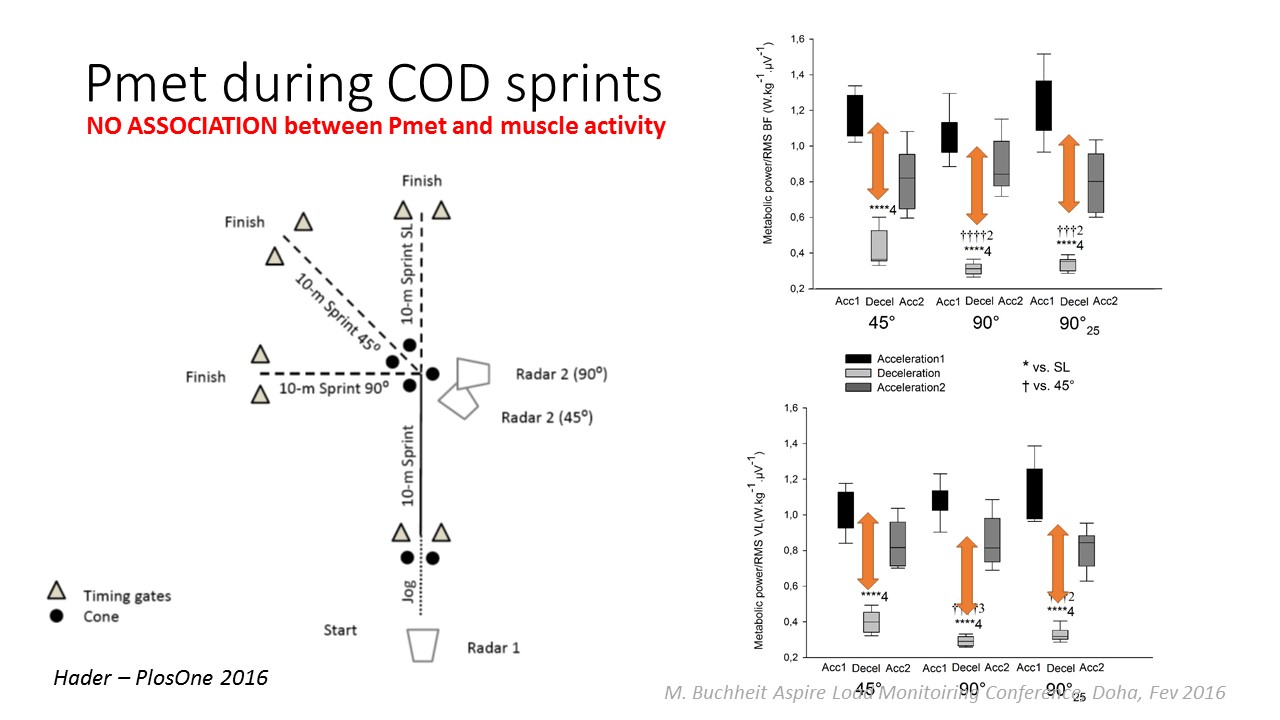
- PGPS, if it was to be used as a global marker of mechanical work, wouldn’t allow deciphering the underlying mechanisms of the load – we rather use distance while accelerating, decelerating and while running at high-speed since those variables may relate directly to the load of specific muscle groups.
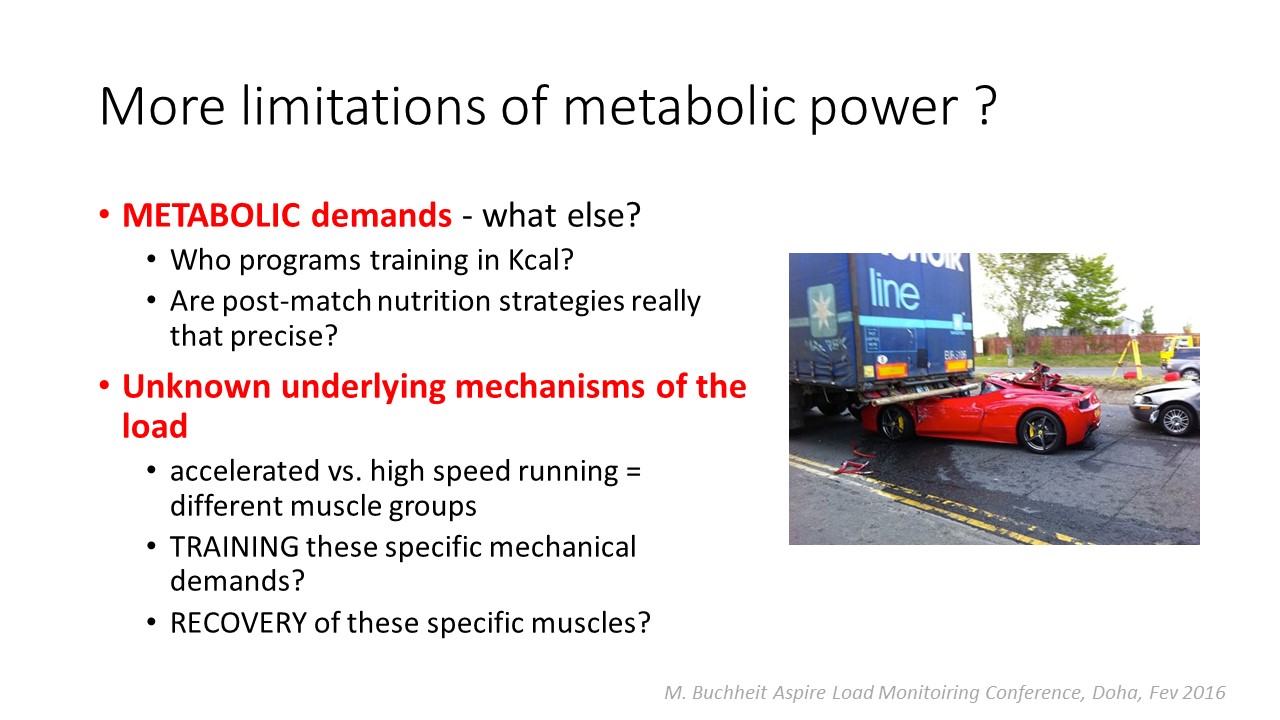
- Injuries are most generally related to inappropriate volumes of accelerations2 or high-speed running;9 there is in contrast little evidence to suggest that spikes in overall energy consumption per se may play a role in injury etiology.
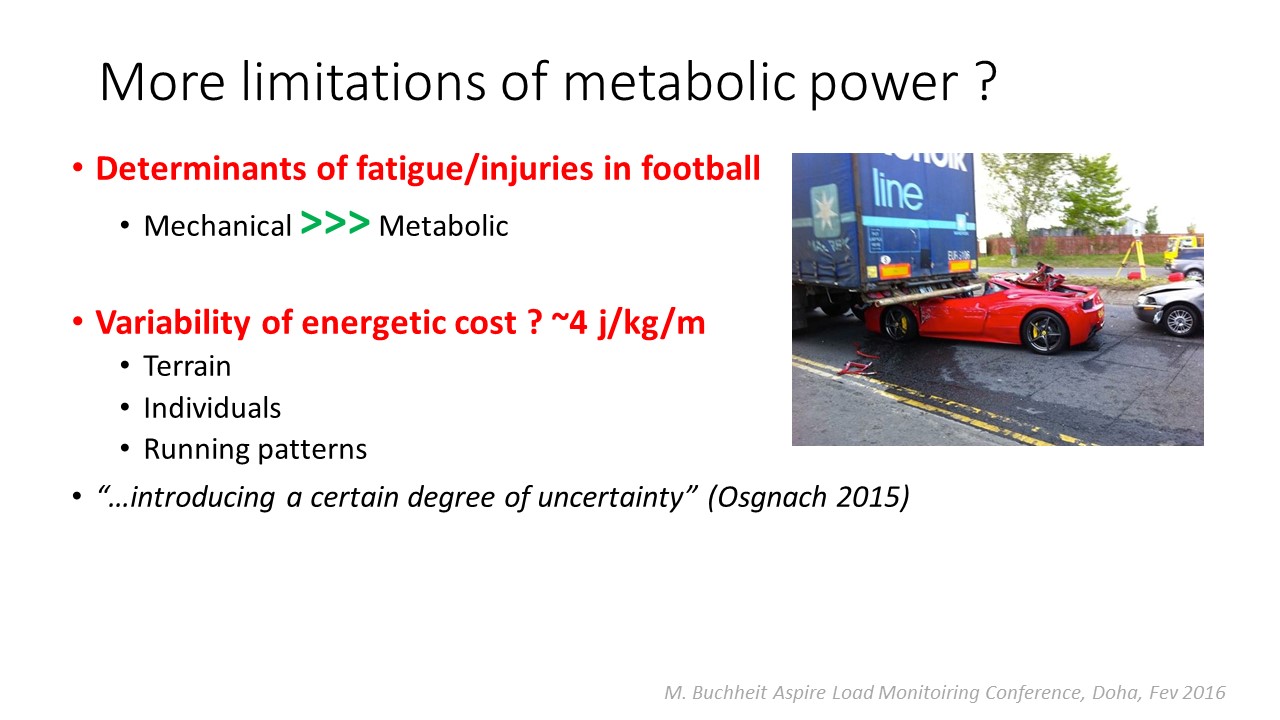
Until new evidences are provided regarding the validity of PGPS as a valid measure of overall energy expenditure during team-sport specific movements, and given the conceptual limitations (difficulties in deciphering the underlying mechanisms of the load), metabolic power assessed via the current technology (PGPS) may not be as powerful as we though to drive Ferraris.
References
- Akenhead R, Nassis GP. Training Load and Player Monitoring in High-Level Football: Current Practice and Perceptions. Int J Sports Physiol Perform. 2016;11(5):587-93.
- Bowen L, Gross AS, Gimpel M, Li FX. Accumulated workloads and the acute:chronic workload ratio relate to injury risk in elite youth football players. Br J Sports Med. 2016.
- Brown DM, Dwyer DB, Robertson SJ, Gastin PB. Metabolic Power Method Underestimates Energy Expenditure in Field Sport Movements Using a GPS Tracking System. Int J Sports Physiol Perform. 2016.
- Buchheit M, Manouvrier C, Cassirame J, Morin JB. Monitoring Locomotor Load in Soccer: Is Metabolic Power, Powerful? Int J Sports Med. 2015;36(14):1149-55.
- Buchheit M, Allen A, Poon TK, Modonutti M, Gregson W, Di Salvo V. Integrating different tracking systems in football: multiple camera semi-automatic system, local position measurement and GPS technologies. J Sports Sci. 2014;32(20)(20):1844-57.
- Coutts AJ, Kempton T, Sullivan C, Bilsborough J, Cordy J, Rampinini E. Metabolic power and energetic costs of professional Australian Football match-play. J Sci Med Sport. 2015;18(2):219-24.
- Cummins C, Gray A, Shorter K, Halaki M, Orr R. Energetic and Metabolic Power Demands of National Rugby League Match-Play. Int J Sports Med. 2016;37(7):552-8.
- di Prampero PE, Fusi S, Sepulcri L, Morin JB, Belli A, Antonutto G. Sprint running: a new energetic approach. J Exp Biol. 2005;208(Pt 14):2809-16.
- Duhig S, Shield AJ, Opar D, Gabbett TJ, Ferguson C, Williams M. Effect of high-speed running on hamstring strain injury risk. Br J Sports Med. 2016.
- Hader K, Mendez-Villanueva A, Palazzi D, Ahmaidi S, Buchheit M. Metabolic Power Requirement of Change of Direction Speed in Young Soccer Players: Not All Is What It Seems. PLoS One. 2016;11(3):e0149839.
- Highton J, Mullen T, Norris J, Oxendale C, Twist C. Energy Expenditure Derived From Micro-Technology is Not Suitable for Assessing Internal Load in Collision-Based Activities. Int J Sports Physiol Perform. 2016.
- Malone S, Solan B, Collins K, Doran D. The metabolic power and energetic demands of elite Gaelic football match play. J Sports Med Phys Fitness. 2016.
- Osgnach C, Poser S, Bernardini R, Rinaldo R, di Prampero PE. Energy cost and metabolic power in elite soccer: a new match analysis approach. Med Sci Sports Exerc. 2010;42(1):170-8.
- Osgnach C, Paolini E, Roberti V, Vettor M, di Prampero PE. Metabolic Power and Oxygen Consumption in Team Sports: A Brief Response to Buchheit et al. Int J Sports Med. 2016;37(1):77-81.
- Stevens TG, de Ruiter CJ, van Maurik D, van Lierop CJ, Savelsbergh GJ, Beek PJ. Measured and Estimated Energy Cost of Constant and Shuttle Running in Soccer Players. Med Sci Sports Exerc. 2015;47(6):1219-24.
- Vescovi JD. Locomotor, Heart-Rate, and Metabolic Power Characteristics of Youth Women’s Field Hockey: Female Athletes in Motion (FAiM) Study. Research quarterly for exercise and sport. 2016;87(1):68-77.


